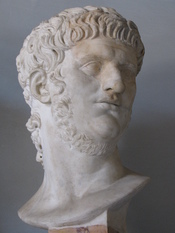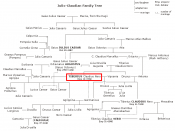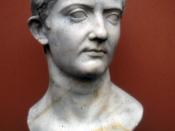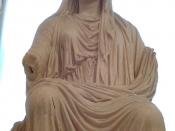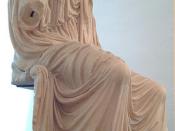Julio - Claudians "Although they often received bad reviews from their contemporaries, the Julio-Claudians provided Rome with consistent, if not spectacular, leadership. Assess the reliability of our sources on the Julio-Claudians and account for their views"ÃÂ The death of Augustus did not see the end of the principate. Instead, it continued to develop along the lines he had created. One of the most influential factors in determining the direction of the principate was Augustus' adoption of Tiberius as his successor. Through this action, Augustus created the beginning of a line of emperors who came to be known as the Julio-Claudians who ruled Rome until the death of Nero in AD 68.
The Julio-Claudians emperors were Tiberius, Gaius (Caligula), Claudius and Nero. They ruled the Roman Empire from AD 14-68. They have today, become some of the best known emperors of the Roman Empire.
The major sources of information about the Julio-Claudians emperors are the works of Tacitus and Suetonius.
It is said that both writers used information, which suited their purposes and, therefore, should be considered as unbalanced views. Both Suetonius and Tacitus tended to ignore the empire when there was peace and prosperity. They neglected to mention matters like the effective administration of the empire, giving a distorted evaluation of the emperors. They also did not mention the growth and prosperity in the empire during the reign of the Julio-Claudians. This indicates that the emperors must have been far more capable than their reputations indicate.
Tacitus and Suetonius both gave the emperors negative reputations. Historians later tended to follow the opinion made and took the lead of these ancient writers.
The first four successors of Augustus were called the Julio-Claudian emperors, as all of them were related either to the Julian or the Claudian family.
Tiberius (C.E. 14-37), unlike his predecessor, lacked popularity and charisma, but was both a competent commander and ruler. The reign of Tiberius started with revolts of Roman armies in Germany and Hungary, which were crushed shortly afterward. The new emperor divested the people of the right to choose the magistrates, transferring the power to the Senate. Tiberius halted the German campaign of his son-in-law, Germanicus, in C.E. 16, because of excessive cost of campaigning. But two years later, Cappadocia (eastern Turkey) was added to the Roman Empire.
The reign of Tiberius was disturbed by the ascendance of Sejanus, who aspired to be the next ruler and wielded so much influence until his execution that a fearful and embittered Tiberius left Rome permanently. During the last part of his reign, an increasingly suspicious Tiberius had many senators and public officials executed on charge of treason. Tiberius generated a huge surplus in the treasury through high taxation, but lent money without interest to the needy during the economic crisis of Rome during C.E 33. Yet, his last years were so shaded with court intrigue and royal persecution that people were relieved at his death.
The successor of Tiberius was his grandson, Gaius, better known as Caligula (C.E. 37-41), initially a popular and competent ruler. He abolished the treason trials ordered by Tiberius and restored to the people the right to elect the magistrates. But after a spell of serious illness, he may have suffered from some form of insanity. He committed sexual excesses and indulged in strange acts (once he declared a horse as his Prime Minister). He thought of himself as god, introduced elaborate court ceremonials, and behaved like a criminal until he was murdered by the praetorian guards who placed upon the throne his partially disabled uncle, Claudius.
Claudius ( C.E. 41-54 ) ruled much better than anyone had ever expected of him. He governed the empire efficiently, gave generous grants of Roman citizenship to subjects, and improved the Augustine civil service by creating four new administrative bureaus under freed men. During his reign, Lycia (part of south-western Turkey, in C.E. 43), Mauretania (the coasts of Morocco and Algeria, in C.E. 44, Thrace (Bulgaria, in C.E. 46), and southern Britain (by C.E. 47) were conquered. The emperor's niece and fourth wife, Agrippina the Younger, persuaded him to name her son (by a previous marriage), Nero, to be the successor. Four years later, Claudius was poisoned to death by Nero's mother.
Nero (C.E. 54-68), like Caligula, started by ruling well, especially under the regency of his dominating mother and his tutor, Seneca. But Nero, resentful of his mother's growing influence, soon murdered his mother and sent Seneca to retirement (which later drove him to suicide). A cruel ruler given to undignified conduct in public, Nero became worse than Caligula as a tyrant, executing all potential rivals as his reign degenerated to terror. When a fire in C.E. 64 destroyed half of Rome, Nero found it convenient to forward his grand architectural project of a personal "Golden Palace" in place of the burnt Forum, and also to persecute brutally the Christian sect for committing the alleged arson. Although many suspect, without proof, that the emperor himself engineered the fire, Nero afforded great help to private individuals to rebuild the burned-down city.
Nero governed the provinces effectively; a tribal revolt in Britain was suppressed in C.E. 61, and in C.E. 63, his able general, Corbulo cleared Armenia of the Parthians. But as Nero ruled arbitrarily and executed many people around him (including Corbulo) on mere suspicion, more revolts by Roman governors flared up in C.E. 65. Gaul (France) and Spain (under Galba), and spread to North Africa. The senators and the praetorian guards in Rome declared their support for the advancing Galba, and the emperor committed suicide.
The reign of the Julio-Claudian emperors saw the alienation and demoralisation of the upper classes. The general populace benefited from the entertainment and support provided by each emperor.
A summary of the reign of each emperor from AD 14-68 would reveal that each of the emperors had both strengths and weaknesses and began his reign with promise, restraint and potential stability. Unfortunately, all of them at some point in their reign strayed from their positive beginning and used violence and fear to rule the empire.
The death of Nero saw the end of the supremacy of the Julio-Claudians and the beginning of a year of instability during which four different people assumed the position of emperor. Each of these emperors left his mark on Rome.

